三、英语段落写作的基本结构
熟练掌握英语段落写作的基本结构形式是构成写作者英语段落写作能力的重要组成部分。英语段落写作的基本结构,根据不同参照角度,具有以下一些类别类型:
(一)根据段落在文本中的功能和角色,段落可分为引入段、主体展开段、结尾段、过渡段。
1.引入段
引入段基本构成要素:连接/引入部分,主题陈述。
主题连接/引入部分主要在于交代写作者写作该主题背后的有关问题。
引入部分的写作思路方法常常是以解决wh-为出发点,具体来讲,就是围绕为什么要探讨某问题(why),某事情如何(how),什么时候、什么地方发生了什么事(when,where,what)。
主题陈述部分主要在于表明该文本写作的主要观点、思想内容,或该写作要解决一个什么问题。
引入段标准:自然,新奇,简明。
自然是指如何将题目与文章所要表达的主题自然地联系起来。自然的对立面就是勉强、牵强、有失逻辑。
新奇只是指引入的思路和语句形式要有新意,避免几十人、几百人针对同一题目的千篇一律的落套的引入方式,新奇还在于文章的主题思想要有新意。具有新意的文章开头会给读者一个良好的第一印象,既能激发读者阅读兴趣,又能对文章获取高分有益。英语中有一句谚语也可用于写作上,Good beginning is half success。
简明是指引入段要求文笔简洁,主题明确,清晰透彻。如果一个读者在读完了一大段引入段后,尚不明确作者在这篇文章里究竟要做什么,究竟要说什么,这样的开头无论怎样不是一个好的开头。
在一些英语写作教科书中,我们不难找出一些常用的引入段的引入方式或方法,如引言展开法、问题展开法、修辞性问题展开法、个人经历展开法、事实或数据展开法、驳斥展开法等。
然而,在实际的文本写作中,不同类型的实际文本又有它们相对不同的引入段结构,例如议论文有议论文的引入段结构,描写文有描写文的引入段结构等。它们不同的结构反映出它们的不同的展开方式。
议论文引入段的一般结构:主题引入+主题思想陈述。
主体引入部分介绍文章将要谈论或探讨一个什么问题,问题产生的背景,如问题的起源、问题的影响、问题的发展等情况。主题思想陈述在于表达出作者对该问题所持的基本思想、看法和态度,以及文章将以怎样的方式进行议论以达成对该基本思想、看法和态度的有效支持等。
语例:
(1)The Creative Way
Because of the rule which requires us to use standard envelopes,there is a problem about to do with the used ones. After thinking for a long time,I have a few suggestions for dealing with old envelopes.
First of all,…
Secondly,…
Thirdly,…
The fourth use of the old envelopes …
(2)Time Is More Valuable
There is a saying:Time Is Money. It is to say time is valuable. However,in my opinion,time is much more valuable than money for us. If you lose money,you can earn some through making efforts. But if what you have lost is time,you can never have the missed time again.
描写文引入段的一般结构:描写对象的引入+描写对象的总体特征/作者对描写对象的最基本的总体印象。
描写对象的引入在于引入将要描写的是什么问题,如物的描写、人的描写、地点或者是情景的描写等。描写对象的引入常常需要对描写的对象进行简要的介绍。描写对象的总体特征/作者对描写对象的总体印象在于对读者呈示出写作者对该描写对象的基本印象。
语例:
XXX college is situated about six miles from a medium-size city with a purely rural surroundings. The compus lies on a natural long and narrow land stretch between a lake and a mountain. At any time a day,at any weather conditions and at any season of the year,the lake,the mountain and the compus,all together with the natural surroundings present people who work and study there,a perfect pleasant impression.
叙述文引入段的一般结构:叙述事情或事件引入+叙述事情或事件的基本目的或意义。
语例:
(1)A Visit to Rural Kenya
At the end of July 1995,I boarded a plane that would take me from my home in Cincinnati,Ohio,to Nairobi,Kenya. My parents had always wanted to take our family abroad,but when my mother signed a contract to work for the U.S. Agency for International Development in Kenya,plans materialized,and we were soon on our way to an exotic year in Africa.
(2)When I think of Georgetown University,I think of Washington and world affairs. I do not know yet exactly what type of professional career I will pursue after schooling,but I do know that I wish to be inter-nationally aware and involved,and that Georgetown would provide me with a solid foundation for that goal.(入学申请)
说明文引入段的一般结构:说明的对象引入+说明主题陈述。说明的对象引入在于告诉读者,作者拟就什么内容进行说明,说明主题陈述则在于告诉读者,作者拟就说明对象的哪个或哪些方面进行说明,以及作者拟大致采用什么方式如比较说明、对比说明、举例说明、操作或使用过程等进行说明。
研究论文属于比较规范和专业的文本,因此,研究论文的引入段的结构相对而言要复杂一些。研究论文的引入段一般包括以下几部分:引入所要研究的问题、已有的研究情况、尚未研究或尚需进一步研究的问题、研究的目的、研究的价值意义或论文预计的主要结构情况。
语例:
一篇论文题目为On Foreign Language Learner Errors的引入段。
Introduction
In the area of foreign language teaching,there have been some theories in which foreign language learner errors are analyzed,and diverse methods of dealing with them are suggested. These theories,however,offer different or even contraditory views on errors and completely different strategies in dealing with them. As a result,many foreign language teachers in China feel puzzled when facing their students’ errors. Therefore,it is necessary to make still further research on the domain of error analysis and find proper error-treating ways in China where the number of foreign language learners,already great,is rising.
英语书信引入段的一般结构:写信原因+写信目的或者写信的原因或目的。
语例:
(1)
Dear Mr. President,
I’m very lucky to attend this world-famous university,but I’m afraid I’m not content with the canteen service on campus.(原因)
…
(2)
Dear Sir,
A recent advertisment in the TV Times magazine asks people to consider emigrating to Austria. I would be very grateful if you could give me more information about the possibility of emigrating,particularly information about the help you could offer.(原因和目的)
…
(3)
Dear Mr. Wu,
Your letter of 10 March to the British Council,Beijing,has been forwarded to me,and I am pleased to send you our Prospectus for the summer courses of 2005.(原因和目的)
…(ibid)
2.主体展开段
主体展开段的目的在于为整个文本的思想内容提供信息支撑。展开段是语篇文本最重要的段落主体,一篇文本可以没有引入段,没有过渡段,也可以没有结尾段,但是都存在展开段。因此,展开段的结构常常多种多样。因此,在本章节所讨论的除了引入段、过渡段和结尾段外,其他所有段落的结构都属于展开段落的结构。主体展开段的常见结构如图6-4所示。其展开可参照一般段落的基本要素:主题(包括明示的主题和蕴涵的主题),支撑主题的支撑句。展开段的标准:主题明确,语义逻辑清楚。主体展开段的具体展开情况参见本章节后面部分的讨论。
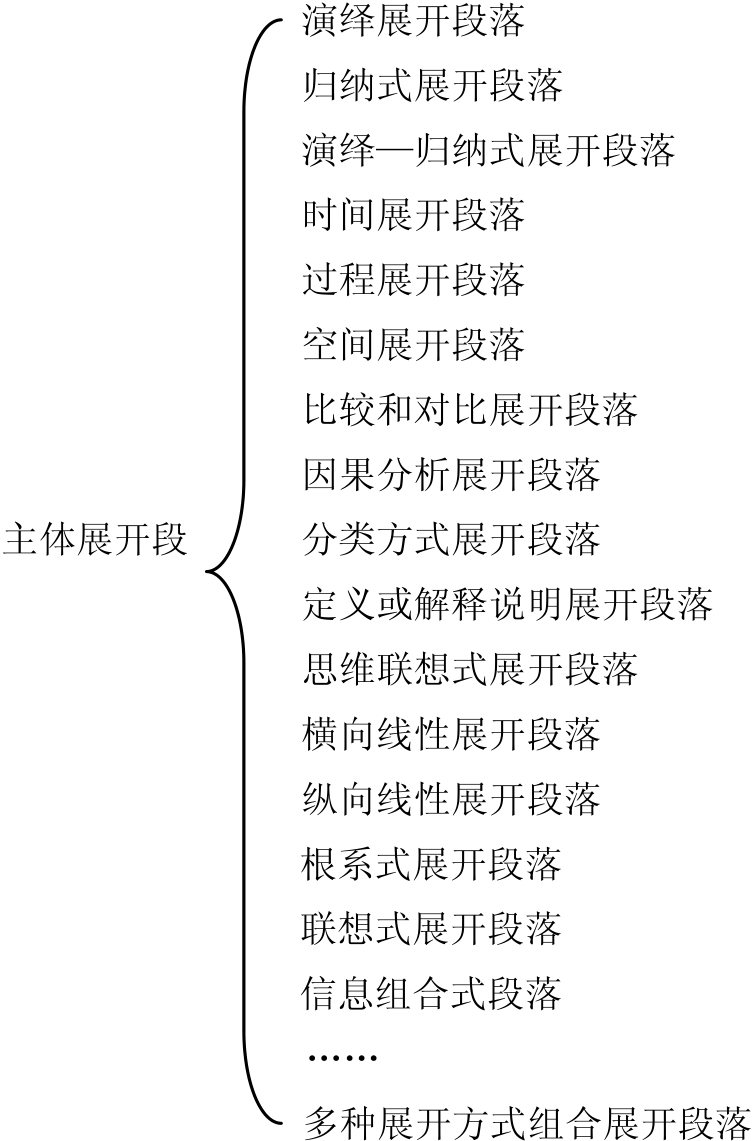
图6-4 主体展开段的常见结构
3.结尾段
结尾段的基本要素:主题的重点和结论。结尾段的标准:简明扼要。
主题重复在于使整个文本首尾照应,让文本给读者一个一气呵成,浑然一体的印象。
结尾段的展开常有以下一些结构模式:主题复述式、主题引申式、展望和期望式、尾首照应式等。
尾首照应式语例:
(1)“There are three kinds of lies-lies,damned lies,and statistics.”Mark Twain.
Well,perhaps Mr. Twaindidn’t see the beauty of numbers the way that I do. Because ever since grade school,mathematics has been my favorite subject.And once I was in college and could focus on many areas of math,I realized that I had a genuine interest to applying mathematical and statistical theories to real-world concerns.Hey,even Twain the skeptic realized the importance of balancing the cargo on shallow,difficult-to-navigate riverboats so that the port and starboardsides were equally laden-he even advised the captains to part their hair down the middle so that the weight was perfectly distributed!
I am eager to start the work that will bring me my Ph.D. in statistics.I am also looking forward to continuing my investigation of how I can apply mathematical theories in the real world.Mark Twainmay despair of my chosen career,but I agree with Thomas Carlyle,who said,Blessed is he who has found his work; let him ask no other blessedness.
(2)Little Lessons I’ve learned on my way...
In his poem,The Road Not Taken,Robert Frost wrote,“Two roads diverge in the woods,and I took the one least traveled by/ And that has made all the difference.”In this poem,the narrator had a choice of two roads.However,I’ve discovered that life is a little more complicated.Sometimes the pathwe embark on is not always the one we choose.Sometimes we are pushed or pulled in certain directions and we have to react to our environment.
And as I offer myself as a Ph.D candidate in your Political Sociology department,I bring to the table years of work experience which includes steady and continuous promotions,an unrelenting pursuit for knowledge,a compassion for children and people,and a belief that anything is possible if we can actively imagine it into existence. Throughout my adult life,I never lost my pathand I hope that you will allow me to continue this path at the University of Nebraska.
结尾段中的结论在于强化文章主要思想,给读者一个完结的交代。
4.过渡段
过渡段承担段落间的衔接、转承的角色任务。标准:自然,承上启下。
(二)根据文本功能和角色为标准,可以将文本段落分成引入段、展开段、结尾段、过渡段四种段落类型,它们各自都承担和履行了不同的文本功能和角色。而相比之下,对于一篇文本的语义思想的表达和阐释,文本的主体展开段落则无疑是起着最主要的作用。也就是说,文本的主体展开段主要承担文本的语义思想的表达和阐释的功能。所以,写好展开段落,对文本的思想内容表达具有十分重要的作用。
由于文本的主体展开段主要是服务于文本思想内容的表达的,所以,从这一角度来讲,文本的主体展开段又可称为文本的主题段。随着文本类型和文本的写作目的的不同,文本的主题段的展开可以采取多种多样的方式,如过程式、时序式、举例式、因果分析式等。
首先,根据英语段落的主要目的和基本的文体风格的不同,英语段落可以分为议论段落、描写段落、叙述段落和说明段落。这四种展开模式可以是单独的展开模式,也可以是组合式展开模式。
根据不同文本类型展开的段落,段落分为单一文本类型结构型、复合文本类型结构型。
单一文本类型。文本具有四种基本类型:议论文、说明文、描写文、记叙文。因此,段落也有议论型段落、说明型段落、描写型段落、记叙型段落。
复合文本类型结构段落,则是以一种文本类型为主,兼具其他文本展开方式为辅构成的段落。其中有议论—说明型、说明—议论型、描写—记叙型、记叙—描写型等。
(三)根据段落有无主题句,段落可以分为有主题句段落和无主题句段落。主题句是指用于表达一个段落的主要思想或指示段落主题方向或任务的句子。
有主题句段落。段落里主题句的特征是具有主题句。主题句的出现,理论上可以出现在段落中的任何位置(前面、中间、后面)。主题句放置的位置取决于写作者的思路、展开方法以及文本特点。理论上,有主题句段落和无主题句段落都可以出现在所有类型的文本当中,但相对而言,出于使语义表达更加简明的缘故常用于议论文,说明文则更多地采用有主题句段落。
语例:
There are many part-time jobs for college students who need money to help pay their bills.For students who enjoy talking to customers,sales jobs are ideal. Some people like to find their own customers,so they choose door-to-door sales of products ranging from beauty aids and encyclopedias to vacuum cleaners. Other people prefer working in department stores,where customer finds them. Students who like being around people,but do not want to persuade them to buy anything,might prefer clerking in a grocery or discount store. Those who enjoy providing service to the public might prefer office jobs as secretaries,file clerks,or bookkeepers. And those who like to keep their surroundings clean and neat might find that being dishwashers,stockroom persons,or janitors fills their need for both money and job satisfaction.
无主题段落的特征是没有一个明显反映主题目的的单句语句。无主题段的主题是通过段中所有语句隐含地反映或共同烘托出来。相对而言,无主题句段落更多地用于描写、记叙等文本。
语例:
The room is located on the fifth floor of the high building. One third of its total floor is taken up by a double bed. Facing it,in the corner behind the door,stands a cupboard loaded with pots,bowls,dishes,bottles,and bags of rice and flour. A desk completely fills the gap between the bed and the wall with the window. Behind the desk is a chair,the only one in the room; and it almost touches the boxes and trunks piled against the wall on the opposite side.
主题句段落中,由于有一个明确的主题句来引导段落的展开,在逻辑上,段落中的其他语句都是属于主题句的支撑句,它们自然地与主题句不在同一逻辑层次上。因此,主题句段落属于层级结构的段落,如图6-5所示。
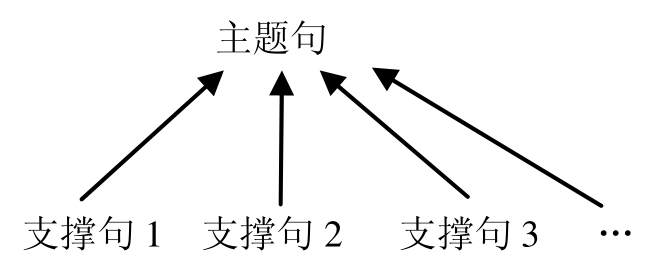
图6-5 主题句段落的层级结构
无主题句段落则不同,其中没有主题句,各个支撑句之间只是平行地指向隐含共同的主题,因此,无主题句段落属于线性结构的段落,如图6-6所示。
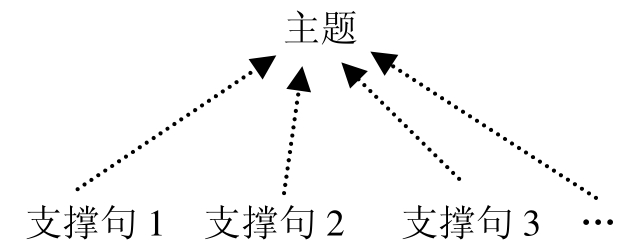
图6-6 无主题句段落的线性结构
(四)根据在主题段落中写作者所运用的不同语义逻辑思维方式,主题段落可以分为时间顺序、空间顺序、演绎、归纳、对比、比较、因果、分类、定义、例证/举例、思维联想等展开模式展开的段落。
1.时间顺序展开段落,包括过程展开段落。标志:动词时态变化和时间或时序指示语,如first,seond,before,after,then,when,1973,2000等。
标准:先后时序清楚。
语例:
We had a number of close calls that day. When we rose,it was obviously late and we had to hurry so as not to miss breakfast; we knew the dining room staff was strict about closing at nine o’clock. Then,when we had been driving in the desert for nearly two hours—it must have been close to noon— the heat nearly hid us in; the radiator boiled over and we had to use most of our drinking water to cool it down. By the timewe reached the mountain,it was four o’clockand we were exhausted. Here,judgment ran out of us and we started the tough climb to the summit,not realizing that darkness came suddenly in the desert. Sure enough,by sixwe were struggling and Andrew very nearly went down a steep cliff,dragging Mohammed and me along with him. By nine,whenthe wind howled across the flat ledge of the summit,we knew as we shivered together for warmth that it had not been our lucky day.
段落中的画线部分为时间标序标志。
2.空间顺序段落。标志:空间及空间关系指示语,如in China,in America,to the east,on the right,before,nearby,between等。
标准:空间位移及关系清晰。
语例:
From a distance,it looked like a skinny tube,but as we got closer,we could see it flesh out before our eyes. It was tubular,all right,but fatter than we could see from far away. Furthermore,we were also astonished to notice that the building was really in two parts:a pagoda sitting on top of a tubular one-story structure. Standing ten feet away,we could marvel at how much of the pagoda was made up of glass windows. Almost everything under the wonderful Chinese roof was made of glass,unlike the tube that it was sitting on,which only had four. Inside,the tube was gloomy,because of the lack of light. Then a steep,narrow staircase took us up inside the pagoda and the light changed dramatically. All those windows let in a flood of sunshine and we could see out for miles across the flat land.
段落中的画线部分为空间位置标志。
3.演绎或归纳段落。标志:演绎或归纳指示语,如illustrate,example,for example,for instance,in conclusion,in short words等。
标准:演绎、归纳逻辑清楚。
演绎/例证型展开段落。演绎/例证型展开段落常常带有example,for example,for instance等标志性词语,有时也没有,而是在一个一般性的命题或一个明确的主题后直接陈述支撑性的事例。演绎/例证型展开段落,无论有无标志性词语,标准在于:段落具有明确的支撑和被支撑的逻辑关系,其次,支撑的例子应力求典型、具体,且如果有多个例子,那么例子之间应有诸如时间、空间、主次等逻辑顺序。例证/举例型展开段落的一般结构模型如图6-7所示。
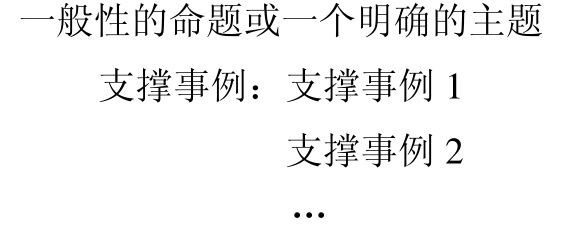
图6-7 例证/举例型展开段落的一般结构模型
语例:
We may note in passing that,although Dr Johnson’s friend and biogrpher(boswell)was a Scotsman,Johnson despiced,or pretended to despice,Scotsmen in general. He once said that the best thing a Scotsman ever saw the high way to England. In his famous dictionary,Johnson defined oats as a grain which in England is generally given to horses,but in Scotland supports the people’. He did not condemn all Scotsmen,however. Once he commented on a distinguished nobleman who had been born in Scotland but educated in England,saying that much could made of a Scotsman—if he was caught young.
在这个段落中作者用了三个例子来支撑主题:Johnson despiced,or pretended to despice,Scotsmen in general。三个例子分别为:He once said …; In his famous dictionary …; Once he commented …。
与演绎/例证不同的是,归纳则是先进行一定的事例呈示,然后,再出现一个一般性的命题或一个明确的主题。
4.对比或比较段落。标志:对比,比较指示语,如on one hand,on the other hand,different from,different,like,likewise,same,similar等。
标准:(1)异同点典型、鲜明。(2)对比点或比较点符合主题需要。(3)异同点描述或分析条理清楚。比较是针对不同对象的相同或相似之处,对比则相反,针对的是不同对象的差异之处。在比较或对比写作中要抓住对象间的典型和鲜明的共同点(相似点)或不同点,才能给读者深刻的印象和说服力。另外,进行比较和对比的着眼点还必须有利于段落的主题思想的表达,否则进行的比较和对比则失去意义。
最后,为了在写作中将异同点描述或分析得条理清楚,人们一般在比较或对比展开段落中遵循两种结构类型:一种类型为对象—特征型;另一类型为特征—对象型。对象—特征型就是在比较或对比中以比较或对比的对象为主线进行比较或对比,在展示完一个对象的必要特征之后,再进行第二个对象,再进行第三个对象,如此以往,只是在每个对象后罗列的各个方面的特征应按同一顺序,以保持段落的连贯。这种类型的比较或对比又被称为整体比较型或整体对比型(Block comparison/contrast)。在实际写作中,有时进行比较的对象并不仅限于两个。
对象—特征比较或对比类型结构模式:
对象1—特征A,特征B,特征C……
对象2—特征A,特征B,特征C……
对象3—特征A,特征B,特征C……
特征—对象型则刚好与上述相反,是以某方面的特征为主线,逐个对比较或对比的对象进行比较或对比,比较或对比完一个特征后,再进行第二特征,再进行第三个特征,如此以往。这种类型的比较或对比又被称为逐点比较或逐点对比型(Point-to-point comparison/contrast)。
特征—对象型比较或对比结构模式:
特征A—对象1,对象2,对象3……
特征B—对象1,对象2,对象3……
特征C—对象1,对象2,对象3……
在整体法和逐点法的运用上,通常,当面对相比的对象的特点较多且较复杂时,最好采用整体法,即将一个对象的特点进行全面系统的陈述或分析后再依次进行第二或第三个对象,这样以便于读者更方便、清楚地了解相关的思想内容。
下面是一个整体法的写作语例:
Although Ulysses S. Grantand Robert E. Leewere fierce adversaries during the Civil War their lives,both military and nonmilitary,had a great deal in common. Grant descended from a family whose membere participated in the American Revolution. He received his commission of second lieutenant from West Point and served in the Spanish-American War. He was later summoned by President Lincoln to assume command of the Union Forces during the Civil War. After the Civil War,Grant suffered financial problems and Was forced to declare bankruptcy. Lee aee also descended from family which engaged in the American Revolution. He,too,received his commission from West Point and later fought in Mexico during the Spanish-American War. His fame as a military stragist during the Civil War,when he was the commander of the Confederate armies,is well known. Although it is not always pointed out by historians,he,like Grant,had financial difficulties after the Civil War and was commpelled to declare bankruptcy. By securing a post as president of Washington College,he was able to avoid additional poverty.
在上述的语例中Ulysses S. Grant and Robert E. Lee为进行比较的两个对象,作者在先陈述了Ulysses S. Grant 的情况后,再陈述了Robert E. Lee的相应情况,于是给读者一个完整而清楚的了解。
5.因果分析展开段落。要素:因果关系。标志:because,for,so,therefore,consequently,thus,reason等。
标准:清楚和严密的因果逻辑。
结构形式:原因—结果型,结果—原因型。前者以作为原因的事实和事件出发,对该事实或事件的结果进行分析、说明、预测等;后者刚好相反,以作为结果的事实和事件出发,对原因进行分析和说明。
语例:
One wonders how,then,these students arrived at such a false conclusion. One reason,ofcourse,may be that they’re science students. Scientific terms generally possess only,precisely defined,meaning. It is,in fact,exactly this quality that make these words distinctive in English,or indeed in any other language. Another reasoncould be the way in which these students were taught English. For example,long vocabulary lists are still an important feature in the foreign language learning programmes of many countries. On one side of the page is the word in English; on the other side a single word in the student’s native language.
6.分类展开段落。一是指对某一事物分解各个部分或对众多个别性的事物进行归类而加以议论、说明、叙述或描写展开的段落。要素:分类。标志:divide,groups,types,sides,kinds…
标准:分类参照体系明确而严密,分类参照服务于主题思想。分类参照体系明确而严密,目的是为了使分解出的各个部分间以及所归类出的类别界线清楚,互不重复、混淆,特征明显,能有效增强文本的说服力和感染力。分类参照服务于主题是指分类中,按照所选参照进行的分类对段落文本的主题思想具有实质性的意义。
结构形式:分解型分类和归类型分类。
分解型分类面对的对象是一个整体或一个系统的概念。写作中,作者为了对该整体或笼统的概念有个清楚的交代,会采用分析、说明、描写等将其分成多个部分。必要时,还会将分出的部分再分出更次一级的若干部分。其参照是找出一些差异性特征。让读者对之有深入具体的认识,归类型分类是作者对多个个别事物或事例归类成数量又较少的几个大类,进行议论、说明等。必要时,作者还会将数量较少的几个大类再进行数量更小的归类。归类的目的是让读者对具体事物有一个总体的认识。归类分类的标准是找出事物之间的一些共性特征。
语例:
There are many part-time jobs for college students who need money to help pay their bills.For students who enjoy talking to customers,sales jobs are ideal. Some people like to find their own customers,so they choose door-to-door sales of products ranging from beauty aids and encyclopedias to vacuum cleaners. Other people prefer working in department stores,where customer finds them. Students who like being around people,but do not want to persuade them to buy anything,might prefer clerking in a grocery or discount store. Those who enjoy providing service to the public might prefer office jobs as secretaries,file clerks,or bookkeepers. And those who like to keep their surroundings clean and neat might find that being dishwashers,stockroom persons,or janitors fills their need for both money and job satisfaction.
7.定义展开段落。定义,就是给一个事物的概念作一个解释或界定,以让人明白,有所了解。通过这种方法展开的段落就是定义展开段落。要素:概念,概念的解释。
标准:客观,清晰明了,基于读者对象。写作中,良好的定义不仅要求清晰明了,揭示概念的本质特征,还应考虑读者对象。比如说,你在写某一产品的说明书时,涉及某一特定事物的概念时,写作尚需考虑读者对象是专业同行还是普通的产品使用者,针对不同的读者对象所做的定义应有所不同。因此,定义常常可以是一个句子,可以是一个段落,甚至也可以是一篇完整的语篇文本。客观指的是所做的解释应是客观的,应尽量避免渗入作者任意的想象或情感的发挥。
语例:
Outlining is a skill that will be useful to you when you are taking lecture notes,reading,or writing a paper. An outline shows the organization of a lecture or a written article. It is an arganized list of ideas,grouped together in such a way as to show their relationship to one another.
8.联想式展开段落。联想式段落的展开是基于写作者针对某一主题的思维联想。当然,这种联想是指有意识的、有控制的基于主题之下的合理的联想,而不是毫无目的的自由式的联想,因为写作本身就是具有一定目的性的有意识行为。联想式展开段落是一种常见的段落展开方式,可以出现在多种文本类型的写作情况中,如议论文、诗歌、散文、描写等。
联想式展开段落与信息组合展开段落既有一定的联系,又有一定的区别。二者之间的联系在于,联想展开的结果最终是体现在呈示给读者一定的信息组合,以便让读者对某一主题进行了解和认知。二者的区别在于,联想展开的段落更多地偏重于写作者对所写的主题的个人的认知感受或经验,而信息组合展开段落则更多地取决于人们普遍的对某一事物或主题的认知序,而这种人们普遍的对某一事物或主题的认知序对于一个写作者而言,实际上就是一种知识序,例如在写一个通知时,一般会涉及通知的人物对象,通知中所涉及的具体事情,以及事情的时间、地点、事情的具体内容等;在写一个招聘广告时,一般会涉及招聘单位的介绍说明、工作和职位说明、招聘对象的条件和要求、具体招聘程序等。
因此,联想式段落展开主要是一种建立在写作者个人的对某一主题的认知联想基础之上的广为写作者采用的段落展开方式。联想式段落的展开表现为基于某一主题的在时空上的或同一主题方向的联想以及各种形式的比喻展开。文学上的意识流流派的文本的段落也是一种典型的联想式展开段落。
语例:
(1)So let freedom ring from the prodigious hilltops of New Hampshire. Let freedom ring from the heightening Alleghenies of Pennsylvania. Let freedom ring from the snow-capped Rockies of Colorado. Let freedom ring from the curvaceous slopes of California. But not only that,let freedom ring from Stone Mountain of Georgia. Let freedom ring from Lookout Mountain of Tennessee. Let freedom ring from every hill and molehill of Mississippi,from every mountainside. Let freedom ring and when this happens,when we allow freedom ring,when we let ring from every village and every hamlet,from every slate and every city,we will be able to speed up that day when all of God’s children,black men and white men,Jews and Gentiles,Protestants and Catholics will be able to join hands and sing in the words of the old Negro spiritual,“Free at last,free at last,thank God Almighty,we are free at last.”
(2)“I love all that thou lovest,
Spirit of Delight!
The fresh earth in new leaves dressed,
And the starry night,
Autumn evening,and the morn
When the golden mists are born.
I love snow,and all the forms
Of the radiant frost;
I love waves and winds and storms,
Everything almost
Which is Nature’s,and may be
Untainted by man’s misery.”
(五)根据段落所要解决的文本语义的重要性和复杂性,段落可分为长段落和短段落。长段落比短段落占据更多的文本空间或拥有更多的字数。长段落和短段落的划分只是一个相对的划分。尽管如此,这样的划分仍对写作学习者具有一定的价值。它可以让写作者在写作中对段落的长度会形成一定的控制意识。
首先,段落的长度是由各个段落在一个特定文本中的相对角色和该段落所要交代的思想的复杂性,以及该段落的思想对整个文本主题思想支撑的重要性所决定的。段落的相对角色,比如,在首尾段与展开段之间,一般而言,首尾段为相对的短段落而展开段则是相对的长段落,另外,过渡段一般比较短。其次,一个段落所要交代的思想内容较复杂,段落则比较长,反之则比较短。最后,几个段落同属展开段,但每个段落所要交代的思想对于反映整个文本主题而言,并不是具有同等重要性和意义的。这时,对主题更重要和更有意义的段落,作者会进行更充分的交代或展开,这样的段落则相对较长,反之则较短。
(六)根据所履行的主题任务的不同,英语段落可分为语义逻辑思维展开型段落、信息组合展开型段落、语义逻辑思维—信息组合结合展开型段落。
语义逻辑展开型段落的展开方式就是如前面所讨论的依据一定语义逻辑思维,如因果、主次、比较对比、时间顺序、空间顺序、演绎、归纳等进行段落的展开。而在实际的文本写作中,一个段落的展开有时基本上是简单的信息组合,也就是说,这样的段落就是简单地将一定的信息组合在一起,就构成了一个段落了。在这样的段落中,其信息的组合也往往并不明显遵循某种语义逻辑。这样的段落可出现在所有文本中,相对而言,更常用于描写文、说明文和一些实用文本中,如图6-8所示。
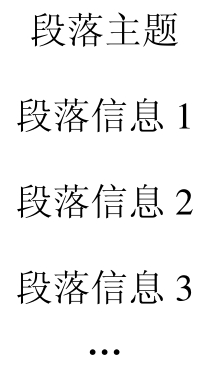
图6-8 信息组合展开型段落展开模式
下面一个主题为自我介绍段落和研究论文中有关研究方法说明的一个一般信息组合结构:
(1)
段落 自我介绍主题段落
段落信息1 出生日期或年龄
段落信息2 基本教育或学历背景
段落信息3 工作职业
…… ……
(2)
段落 研究方法说明段落
段落信息1 研究地点/场合/环境
段落信息2 研究材料选用
段落信息3 研究步骤/程序
段落信息4 研究结果数据处理
…… ……
在上述两个信息组合段落中的各信息成分,无论是自我介绍主题段落中的出生日期或年龄,基本教育或学历背景和工作职业,还是研究论文中的研究方法说明段落中的研究地点/场合/环境,研究材料选用,研究步骤/程序等,它们的组合都未能体现出遵循了某一明显的语义逻辑规律和顺序,它们之间的组合并不存在一个明显的顺序,而更多地取决于写作者的个人倾向和一般其他相应文本的惯常方式。
可见,信息组合展开型段落主要在于各必要信息要素齐备和完善以及各信息要素之间应有较分明的界限,换言之,在运用信息组合方式展开段落时,写作者应注意,为达到该段落的应有表意目的和充分履行该段落的表意功能,所具备的信息要素必须充分和完备,并且,各信息要素之间应相互分明,避免交叉混杂。当一个段落信息交代完之后,再进行第二个信息的交代。
一般而言,出于人们的阅读和思维习惯,以便让读者更加方便地阅读理解文本,在英语写作中,人们也在很多时候采用语义逻辑思维—信息组合结合方式展开段落,在这样的段落中既体现了语义逻辑,又体现了一定的信息组合。
(七)根据主题段落展开的语法逻辑结构层次,主题段落的展开可以分为横向线性展开段落、纵向线性展开段落以及纵向非线性展开段落或根系式展开段落。
横向线性展开段落一般为无主题句段落。在横向线性展开段落中,写作者围绕一个主题进行多个不同侧面的展开,而这些展开的多个不同侧面相互之间在文本的语法关系上是平行或并列的关系。而在文本的语义上,也许作者会出于不同的语义表达目的而采用不同的逻辑方式,如采用一定的空间顺序、时间顺序,或者从重要内容到次重要内容等方式对文本的内容进行不同的安排,但实际上,这并不影响各内容之间在文本语法意义上的平行或并列关系,即所谓的横向线性展开。如图6-9所示为横向线性展开段落模型。

图6-9 横向线性展开段落模型
在横向线性展开段落中,其主题不是明示的主题,而是一个暗含的主题,所以,在模型图中段落主题与其各个侧面之间的联系只用了虚线表示。横向线性展开模式常常在描写文、记叙文和一些实用文本中被用到。
语例:
My name is Liyuan. I was born in 1975. Now I am an English teacher. My hobby is travel and sports. I am 175cm tall and my weight is 175 pounds.
在这样一个段落中,显然,各个句子都处于一个平等的关系上。
纵向线性展开段落就是在段落展开中,写作者就某个段落的主题进行单维度的层层深入式的展开。纵向线性展开,尽管从理论上可以有演绎式和归纳式两种方式,但是,在人们的实际写作中,演绎式纵向线性展开段落则更为常见,大概这更符合人们的思维习惯。在纵向线性展开段落中,段落的主题句放置于段落的前面,然后逐层地对代表段落主题的主题句进行展开说明,或论述、或描写等,其显著特点是:每后面一层的展开,都逐次是前面与之相邻一层的支撑。前后层次之间的关系是支撑与被支撑的关系。纵向线性展开段落的展开模型如图6-10所示。
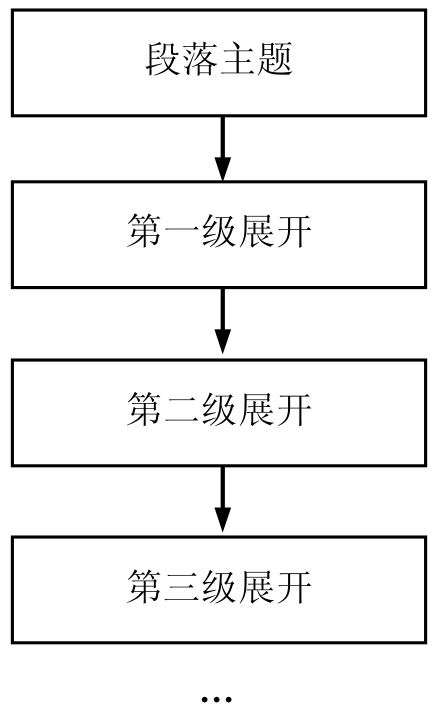
图6-10 纵向线性展开段落的展开模型
语例:
In preparation for sovereignty,many functions of government have already been transferred. Twelve government ministries are currently under the direct control of Iraqis. The Ministry of Education,for example,is out of the propaganda business,and is now concerned with educating Iraqi children. Under the direction of Dr. Aladin al-Alwan,the Ministry has trained more than 30 000 teachers and supervisors for the schools of a new Iraq.
在上述这个段落中,可以清晰地看出其逐层展开的纵向线性结构:
段落主题preparation for sovereignty。
第一级展开many functions of government transferred。
第二级展开Twelve government ministries under the control。
第三级展开The Ministry of Education now concerned with educating。
第四级展开the Ministry has trained more than 30 000 teachers and supervisors。
与前面两种展开形式相比,纵向非线性展开段落或根系式展开段落就要复杂得多了。纵向非线性展开段落实际上是横向线性展开段落和纵向线性展开段落的结合形式,具有它们共同的特征。根系式展开段落实际上就是主题句段落中围绕段落主题进行的多侧面和多层次的展开,如图6-11所示。
纵向非线性展开段落或根系式展开段落常用于议论文和研究论文的展开,适于表达较复杂和系统的思想观点。
英语段落因为不同的展开方式而具有不同的结构类型。除了上述讨论的段落结构类型外,显然还应存在更多的段落类型。在实际写作中,一个段落往往并不是以某一种方法展开的,而是由两种或两种以上的方法展开的。例如,为了表达的需要,一个段落甚至可以由很不相近似的方法共同展开,如时空型段落、定义—推演型、分类比较型、分类对比型、因果分类型、分类因果型等等。
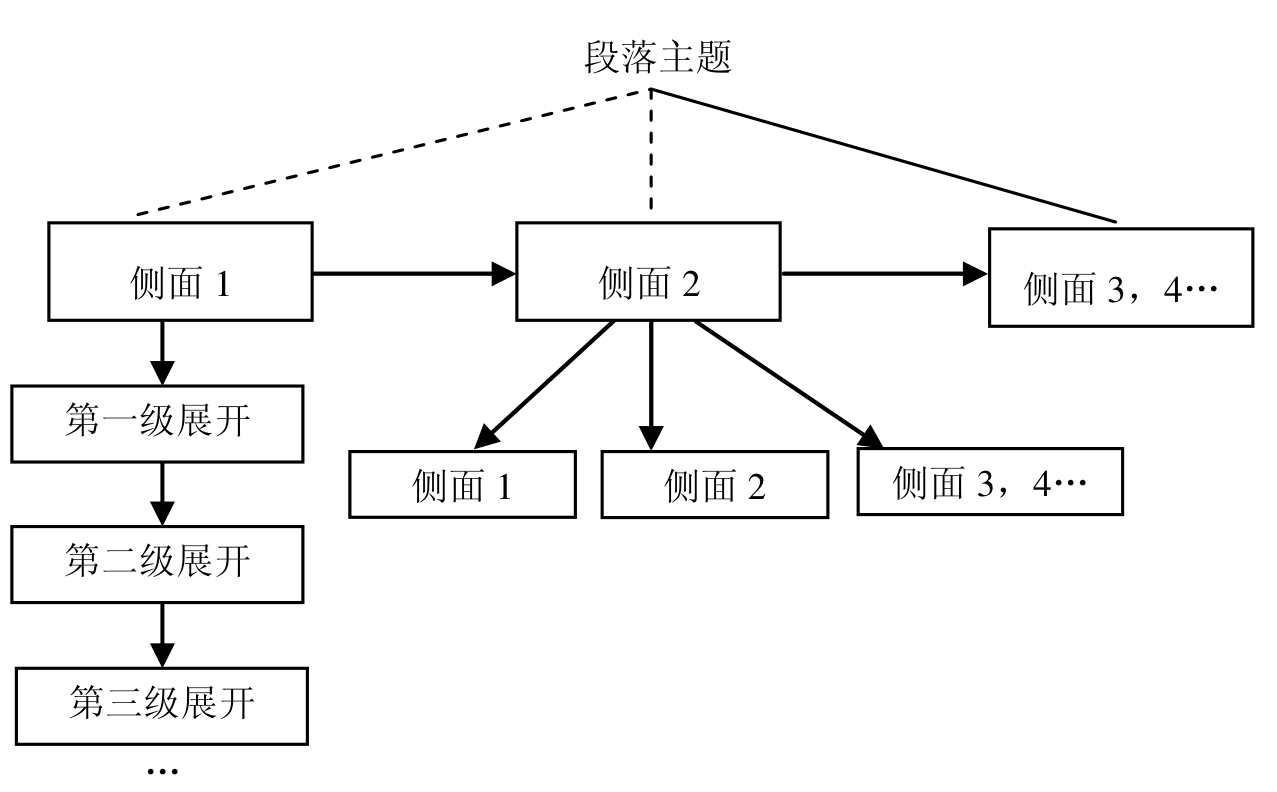
图6-11 纵向非线性展开段落或根系式展开段落模型
因此,英语写作者应了解和熟练运用多种英语段落的结构,才能具备更好的英语段落写作能力。
免责声明:以上内容源自网络,版权归原作者所有,如有侵犯您的原创版权请告知,我们将尽快删除相关内容。
















